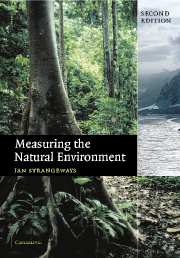Book contents
- Frontmatter
- Contents
- Acknowledgements
- 1 Basics
- 2 Radiation
- 3 Temperature
- 4 Humidity
- 5 Wind
- 6 Barometric pressure
- 7 Evaporation
- 8 Precipitation
- 9 Soil moisture and groundwater
- 10 Rivers and lakes
- 11 Data logging
- 12 Telemetry
- 13 Visibility
- 14 Clouds
- 15 Lightning
- 16 The upper atmosphere
- 17 The oceans
- 18 Cold regions
- 19 Remote sensing
- 20 Atmospheric composition
- 21 Forward look
- Appendix: abbreviations and acronyms
- Index
- References
10 - Rivers and lakes
Published online by Cambridge University Press: 05 July 2014
- Frontmatter
- Contents
- Acknowledgements
- 1 Basics
- 2 Radiation
- 3 Temperature
- 4 Humidity
- 5 Wind
- 6 Barometric pressure
- 7 Evaporation
- 8 Precipitation
- 9 Soil moisture and groundwater
- 10 Rivers and lakes
- 11 Data logging
- 12 Telemetry
- 13 Visibility
- 14 Clouds
- 15 Lightning
- 16 The upper atmosphere
- 17 The oceans
- 18 Cold regions
- 19 Remote sensing
- 20 Atmospheric composition
- 21 Forward look
- Appendix: abbreviations and acronyms
- Index
- References
Summary
Going up that river was like travelling back to the earliest beginnings of the world, when vegetation rioted on the earth and the big trees were kings. An empty stream, a great silence, an impenetrable forest. The air was warm, thick, heavy, sluggish. There was no joy in the brilliance of sunshine. The long stretches of the waterway ran on, deserted, into the gloom of overshadowed distances. On silvery sandbanks hippos and alligators sunned themselves side by side. The broadening waters flowed through a mob of wooded islands, and butted all day long against shoals, trying to find a channel till you thought yourself bewitched and cut off for ever from everything you had known once — somewhere — far away — in another existence perhaps.
Joseph Conrad Heart of Darkness (steaming up the Congo River).Sensors for measuring the quality and quantity of surface water, including the oceans, and groundwater are similar in principle, and so it makes for greater clarity if this chapter is organised by sensor type rather than by application.
Measuring water level
Staff gauges
Graduated staff gauges are widely used for the manual measurement of rivers, lakes and sea level. They are usually installed vertically in the river bed or fixed to a weir (Fig. 10.1(a)), bridge or harbour wall. Boards are made in 1-m and 2-m lengths and are about 15 cm wide, fixed one above the other to cover greater depths, and marked to span up to 12 m, or more.
- Type
- Chapter
- Information
- Measuring the Natural Environment , pp. 223 - 271Publisher: Cambridge University PressPrint publication year: 2003



